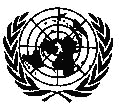ECONOMIC AND SOCIAL COMMISSION FOR ASIA AND THE PACIFIC
Promotion of Non-Handicapping Physical
Environments for Disabled Persons:
Case Studies

United Nations
New York, 1995
ST/ESCAP/1510
The designations employed and the presentation of the material in this publication do not imply the expression of any opinion whatsoever on the part of the Secretariat of the United Nations concerning the legal status of any country, territory, city or area, or of its authorities, or concerning the delimitation of its frontiers or boundaries.
The opinions, figures and estimates set forth in this publication are the responsibility of the authors, and should not necessarily be considered as reflecting the views or carrying the endorsement of the United Nations.
Preface
The themes of the United Nations Decade of Disabled Persons, 1983-1992, were the prevention of disability, the rehabilitation of disabled persons and the equalization of their opportunities in society. Notwithstanding its economic improvements, the Asian and Pacific region has, together with the largest population of any region, by far the largest number of people with disabilities in the world. The majority of them are poor. This realization, together with the recognition that equalization of opportunities for people with disabilities had been relatively neglected during the United Nations Decade, led to the proclamation of the Asian and Pacific Decade of Disabled Persons, 1993-2002, by the Economic and Social Commission for Asia and the Pacific (ESCAP) at its forty-eighth session at Beijing in 1992.
In pursuance of resolution 48/3 that proclaimed the Decade, ESCAP convened the Expert Group Meeting on the Promotion of Non-Handicapping Environments at Bangkok in June 1994. The expert meeting, organized with the support of the Government of Japan, was attended by 28 persons from 15 countries. It was the first regional meeting convened by the United Nations on the promotion of accessibility to the built environment.
This publication contains a regional overview of access legislation in the ESCAP region and 24 case-studies on access legislation and policy provisions, as well as the roles of education systems, associations of professionals and non-governmental organizations in the promotion of barrier-free built environments. It is based on the papers submitted to the expert meeting.
From the case-studies, it would appear that efforts in this area have focused, thus far, on improving access by persons with disabilities and elderly persons to public buildings. However, the degree to which this has been done varies from country to country, and is, in some measure, dependent -- though not entirely so -- on the level of national economic development. Barrier-free access to public transport, to large-scale commercial buildings and especially to private dwellings, often comes far behind public building provisions.
In several countries, improvements to the mobility of persons with disabilities and elderly persons and their use of facilities and services in the built environment clearly lag behind legal provisions. Even if public buildings are barrier-free, reaching them is often a major problem. The problem of accessibility cannot be tackled piecemeal, but requires a holistic approach, as has been taken in at least one city in the region. Schools of architecture, engineering and urban planning throughout the region have yet to incorporate in their curricula the concept of barrier-free environments. It is important that the curricula be revised to include broad understanding of conceptual issues and user perspectives, as well as simulation exercises on disability. There is a need for architects, engineers and urban planners to realize that token provision of a few reserved parking lots, ramps, toilets and lifts is insufficient. Associations of professionals, notably of architects, have a valuable role to play in improving accessibility. Non-governmental organizations which are involved in promoting access for people with disabilities and elderly persons can play a leading role in helping to advance action on meeting the access needs of all user groups, especially by highlighting in a visible manner the physical barriers to full participation and equality by those who are most marginalized.
This publication is a companion to Guidelines for the promotion of non-handicapping physical environments for disabled persons (ST/ESCAP/1492). It is hoped that they may both serve as useful references on ways of improving access to facilities and services in the built environment from the perspective of all users, including people with disabilities and elderly persons.
Contents
Preface
Chapter I. OVERVIEW OF ACCESS LEGISLATION IN THE ESCAP REGION
- Introduction
- The Current Accessibility Situation in the ESCAP Region
- The Status of Access Legislation
- Access Legislation: Formulation, Scope, Implementation, Enforcement and Evaluation
- Critical Appraisal of Access Legislation
- Promoting Access Legislation in the ESCAP Region - Proposals for Action
Chapter II. NATIONAL-LEVEL ACCESS LEGISLATION AND POLICY PROVISIONS
- Australia (Michael Fox)
- Canada (Robert A. Fern)
- Finland (Maija Konkkola)
- India (Santosh K. Rungta)
- Japan (Hiroyuki Honjo)
- Philippines (Angel Lazaro, Jr)
- Singapore (James D. Harrison)
Chapter III. LOCAL-LEVEL ACCESS LEGISLATION AND POLICY PROVISIONS
- Hong Kong (Joseph Kwan)
- Indonesia (Haryo Winarso)
- Islamic Rep. of Iran (Amir Nourani)
- Japan (Akira Sugiyama)
- Malaysia (Gofrey Ooi Goat See)
- Philippines (Angel Lazaro, Jr.)
Chapter IV. THE ROLE OF EDUCATION SYSTEMS
- Indonesia (Haryo Winarso)
- Japan (Katsushi Satoh)
- Philippines (Angel Lazaro, Jr.)
- Singapore (James D. Harrison)
Chapter V. THE ROLE OF ASSOCIATIONS OF PROFESSIONALS
- Islamic Rep. of Iran (Mehdi B. Ahari)
- Japan (Katsushi Satoh)
- Philippines (Angel Lazaro, Jr.)
- Singapore (Ken Lou)
Chapter VI. THE ROLE OF NON-GOVERNMENTAL ORGANIZATIONS
- The Work of HelpAge International in the Asian and Pacific Region (Finlay Craig)
- Experience of the National Federation of the Blind, India
- The Contribution of Handicapped's Anchor in Christ, Inc. to Accessibility in Cebu City, Philippines
ECONOMIC AND SOCIAL COMMISSION FOR ASIA AND THE PACIFIC
Promotion of Non-Handicapping Physical Environments for Disabled Persons: Case Studies
- Contents -
UNITED NATIONS
New York, 1995
